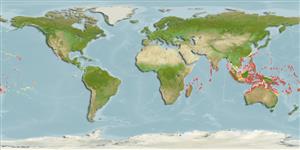>
Holocentriformes (Squirrelfishes, soldierfishes) >
Holocentridae (Squirrelfishes, soldierfishes) > Holocentrinae
Etymology: Sargocentron: Greek, sargos = sargus + Greek, kentron = sting (Ref. 45335).
More on author: Bleeker.
Environment: milieu / climate zone / depth range / distribution range
экология
морской ассоциированный с рифами; пределы глубины 0 - 100 m (Ref. 128797), usually 1 - 15 m (Ref. 27370). Tropical; 30°N - 24°S
Indo-Pacific: Aldabra and the Laccadive Islands (Ref. 4201) to the Society Islands (Ref. 9710), north to Ryukyu Islands, south to the southern Great Barrier Reef; Palau to the eastern Caroline and Marshall Islands in Micronesia.
Size / Вес / Возраст
Maturity: Lm ? range ? - ? cm
Max length : 45.0 cm TL самец/пол неопределен; (Ref. 8631)
колючие лучи спинного плавника (общее число) : 11; членистые (мягкие) лучи спинного плавника (общее число) : 12 - 15; колючие лучи анального плавника: 4; членистые (мягкие) лучи анального плавника: 9. Body color brownish to purplish red; head primarily red; upper part of opercular membrane blackish; each scale with vertical silvery white line. Four to five oblique scale rows on cheek; body depth 2.3-2.7 in SL; head length (HL) 2.4-2.85 in SL; snout length 3.75-4.35 in HL; maxilla extending posteriorly from below front of pupil to below center of the eye, upper jaw length 2.7-2.85 in HL; premaxillary groove about a vertical at front edge of orbit; anterior end of nasal bone with 2 diverging spines; medial margin of nasal bone spineless (however, a Seychelles specimen 20.6 cm has one small spinule on the edge); 1-3 spinules on anterior and posterior margins of nasal fossa; suborbital bones' upper edge smooth anteriorly, becoming slightly serrate posteriorly (serrae as recumbent spinules); adults' preopercular spines long, 2.85-3.8 in HL (at least equal to orbit diameter). 2 opercular spines with the lower nearly as long or equal to the upper spine; 4th dorsal spine longest, .5-2.95 in HL; membranes of spinous dorsal fin not incised; 3rd anal spine 1.5-1.7 in HL (Ref. 27370). Has a high body similar to S. spiniferum, but differs in coloration and does not get as large.
Uncommon in atoll reef flats, lagoon patch reefs, and steep outer reef slopes. Solitary and secretive species, occasionally seen in small crevices in clear water habitats (Ref. 48635). Strictly nocturnal, feeds mainly on benthic crabs and shrimps. Spine of preopercle is venomous. Usually among rich coral growth (Ref 90102).
Life cycle and mating behavior
Maturities | размножение | Spawnings | Egg(s) | Fecundities | личинки
Randall, J.E., 1998. Revision of the Indo-Pacific squirrelfishes (Beryciformes: Holocentridae: Holocentrinae) of the genus Sargocentron, with descriptions of four new species. Indo-Pac. Fish. (27):105 p. (Ref. 27370)
Статус Красного Списка МСОП (Ref. 130435)
Использование человеком
дополнительная информация
инструменты
Специальные отчеты
Скачать в формате XML
ресурсы в Интернет
Estimates based on models
Preferred temperature (Ref.
123201): 25.4 - 29.3, mean 28.5 °C (based on 2812 cells).
Phylogenetic diversity index (Ref.
82804): PD
50 = 0.5000 [Uniqueness, from 0.5 = low to 2.0 = high].
Bayesian length-weight: a=0.01622 (0.00774 - 0.03400), b=2.97 (2.80 - 3.14), in cm total length, based on LWR estimates for this Genus-body shape (Ref.
93245).
Trophic level (Ref.
69278): 3.6 ±0.59 se; based on food items.
устойчивость к внешним воздействиям (Ref.
120179): средний (среднего размера), минимальное время удвоения популяции 1.4-4.4 года (Preliminary K or Fecundity.).
Fishing Vulnerability (Ref.
59153): Low to moderate vulnerability (35 of 100).
Nutrients (Ref.
124155): Calcium = 36.9 [15.0, 137.7] mg/100g; Iron = 0.432 [0.170, 1.218] mg/100g; Protein = 18.7 [17.6, 19.9] %; Omega3 = 0.128 [0.057, 0.285] g/100g; Selenium = 32.5 [20.2, 58.3] μg/100g; VitaminA = 64.4 [25.9, 163.6] μg/100g; Zinc = 1.53 [0.64, 2.83] mg/100g (wet weight);
